 This is an alchemy guide which has been put together through the effort of many testers over many tests. In this guide, I’ll cover basics such as what alchemy is and how to level it efficiently, as well as the complete list of alchemy reagents.
This is an alchemy guide which has been put together through the effort of many testers over many tests. In this guide, I’ll cover basics such as what alchemy is and how to level it efficiently, as well as the complete list of alchemy reagents.
If you are already an experienced alchemist and wish to skip to the list of alchemy reagents discovered, as well as what mixes will potentially be possible, it is located near the end.
Contents:
- Alchemy basics
- Skill points
- List of ingredients
- Ingredient traits
- Interesting potential mixtures
- Closing
Alchemy Basics
Alchemy is a crafting profession which allows one to create mixtures such as potions and poisons. It is by no means a necessary profession, and as I quickly discovered, it is actually very easy to get a stock of basic potions by farming mini bosses. That being said, alchemy is able to create several concoctions that are not found in the game world, including multi-effect potions.
Making potions
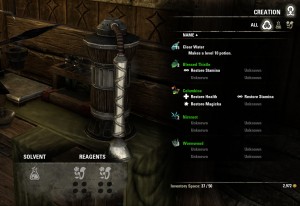 To make a potion, you need at least two ingredients and a solvent. The ingredients you combine determine the effect of the potion, as well as grant you experience points towards alchemy. Every ingredient has 4 ‘traits’ which start off unknown, but you may eat an ingredient to discover the first trait, and conduct experiments to unlock the rest.
To make a potion, you need at least two ingredients and a solvent. The ingredients you combine determine the effect of the potion, as well as grant you experience points towards alchemy. Every ingredient has 4 ‘traits’ which start off unknown, but you may eat an ingredient to discover the first trait, and conduct experiments to unlock the rest.
When you mix two ingredients with the same trait, you receive a potion with that effect – for instance, Water Hyacinth and Wormwood both have “Weapon Crit” as a potential effect, so if you mix the two, you will receive a mixture that boosts your critical strike rating a significant amount.
To create a potion, reagents you mix must have at least one shared effect (for example, Restore Magicka). If the ingredients you use have two shared effects then the potion you create will have two effects (ex. Restore Magicka and Restore Stamina).
It should be noted that there are also ‘anti-traits’ which will prevent you from making certain potion types. For instance, Namira’s Rot+Wormwood+Water Hyacinth would normally make a potion that improves all forms of critical strike as well as adding ‘Unstoppable,’ but because Water Hyacinth features ‘Stun,’ the potion will not be capable of Unstoppable, even though Wormwood and Namira’s Rot both have the trait for it.
Solvents
The solvent is the liquid that you are mixing the potions in, and for now, that solvent is just various kinds of water that you find in the world. The solvent you use determines the level of the potion; a health potion made with the lowest level water will make a level 3 potion, whereas the next grade up will make a potion suitable for a level 10 character.
The first solvent you’ll come across is Natural Water, used for level 3 potions. Later on you’ll be finding Clear Water (level 10 potions), Pristine Water (level 20), Cleansed Water (level 30) and Filtered Water (level 40). Purified Water is used for Veteran-level potions (VR 1-5 zones), and lastly Cloud Mist is used for VR6-10.
Tip: if you’re having trouble finding Purified Water, try searching in Coldharbour.
Solvents are easily found near rivers and lakes, so if you’re near one you may want to take a few seconds to pick it up. You can also find plenty of them in various crates and barrels in the world.
Earning experience
Experience (inspiration) in alchemy is earned by simply making potions. Creating potions with a higher level solvent dramatically increases the experience gained, but higher level solvents require a skill point investment — something which is not in abundant supply for the first few levels.
Making a new potion discovery gives an exp bonus, but it’s rather small compared to what you normally earn for making a potion. Mixing ingredients that don’t result in a valid potion earn you insignificant amount of exp, and should be avoided unless you’re experimenting. Make sure you take a look at our table with ingredient effects below, and don’t waste valuable herbs for potions with no useful effects!
At first you should try to make at least one potion with negative effects. Despite most of these potions being vendor trash, discovering new potions gives a huge amount of inspiration and it’s well worth the investment.
If you’re serious about leveling alchemy, in most cases you will want to craft potions useful for leveling your character. Usually those potions will restore Health and Magicka, though if you only stick to a couple of potion types you will quickly run out of raw materials. Consider selling potions you don’t need in guild stores.
And that’s essentially the best tip for leveling alchemy: simply try to create useful potions with the materials you have. You will have to spend hundreds of herbs to level Alchemy all the way to rank 42 or so (where you can create almost all potions), and farming them is fairly time consuming.
Skill points
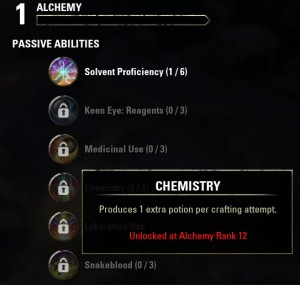 Every crafting profession will require some skill point investments to be of use. You start off with the ability to make potions fit for a level 3 player, but your alchemy is nearly useless at this point in time since you can’t make anything significant yet. Once you level your alchemy and invest skill points, your alchemy will see a boost.
Every crafting profession will require some skill point investments to be of use. You start off with the ability to make potions fit for a level 3 player, but your alchemy is nearly useless at this point in time since you can’t make anything significant yet. Once you level your alchemy and invest skill points, your alchemy will see a boost.
Most other crafts don’t require many skill points to be able to create the best of items, but alchemists may want to consider even fully maxing all passive bonuses in the skill tree.
Alchemy skill line:
- Solvent Proficiency (1/7): Use natural Water for level 3 potions.
- Keen Eye: Reagents (1/3): Reagents in world are easier to see when you’re 20 meters or closer.
- Medicinal Use (1/3): Potion effects last 10 % longer.
- Chemistry (1/3): Produces 1 extra potion per craft attempt.
- Laboratory Use: Allows use of 3 reagents while mixing potions.
- Snakeblood (1/3): Reduces negative effects in potions by 50%.
Related: crafting skill lines.
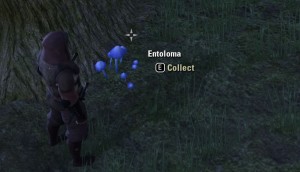
Some ingredients like Entoloma are fairly easy to spot in the world, but some blend in very well into the environment. Keen Eye skill can help you spot them.
The first thing anybody should do, arguably even if they don’t want to pursue alchemy, is to stick a point in the Keen Eye perk. This allows plants to ‘glow’ at a distance of up to 20 meters, which is incredibly useful due to how small some of the plants actually are. Do not underestimate keen eye as I did; even if you are great at spotting plants, you’re not a superhuman, and you will miss a few here and there.
Keen eye is a great tool, though remember you can still spot plants further off than the 20/30 yard range if you look carefully, though keen eye will be what prevents you from missing anything when you’re not paying close attention.
Remember, even if you don’t immediately intend to level up Alchemy, most herbs you pick up are easily worth about 100g each on guild stores, so gathering them can be a valuable source of gold.
Tip: turning off foliage in game’s graphics settings may enable you to spot plants more easily, though it does make the game uglier.
You will want to spend a point in learning how to use the next level of solvents (Solvent Proficiency), if you are interested in pursuing alchemy further. It’s at this point that you have to decide whether or not to be an alchemist, since if you change your mind, any investment in the skill will be wasted points.
Keen eye will at least help you gather herbs to trade with, but learning the next level of solvents won’t help if you don’t become an alchemist. If you do become an alchemist, know that the higher level solvents earn you more exp, and should be learned when you are ready to start using higher level solvents (ideally when you have a lot of water stacked up).
Tip: if you’re having trouble finding solvents, try searching in barrels and crates. It’s the easiest way to get solvents while adventuring. This way you can also get other crafting materials, and racial motifs.
There is a talent further down that allows you to multi-craft potions called Chemistry. In short, you mix ingredients, you get two potions instead of one, and there are multiple ranks. Needless to say, this talent will be vital when you are ready to start mass producing a specific kind of potion.
The most important talent of them all will have to be the triple ingredient talent, Laboratory Use, allowing you to mix 3 ingredients at once. This unlocks an incredible assortment of potential potions, as any third ingredient you use will add a number of effects based on how well it matches against the other two. This is what is going to make alchemist’s potions far superior than anything that can possibly be found while questing. Do note the experience earned does not increase with a third ingredient added; it is purely for making better potions.
Ingredient Traits
This list was brought together by those who took the time to explore the various ingredients and their potential combinations. While I take credit for some discoveries, this could not have been possible without the combined efforts of several posters. Sadly, I do not know the authors of the various incomplete lists whose combined efforts made this one possible, but I extend my thanks to you all the same.
Some plants have environments they are prone to growing in. Water Hyacinth and Nirnroot are exclusively found near water, and mushrooms are exclusively found at the base of rocks or trees. It should also be noted that, as of the writing of this guide, some ingredients are completely unavailable to the starting areas of some factions – Ebonheart Pact for instance is missing several mushrooms. If you are in a guild which makes use of the game’s cross-faction capabilities, consider making friends with someone on the other sides.
This is a list of ingredients and the effects you can discover on them. Essential for creating potions with useful effects!
- Blessed Thistle: Restore Stamina, Ravage Health, Increase Weapon Potency, Speed
- Blue Entoloma: Ravage Magicka, Restore Health, Invisibility, Lower Spell Power
- Bugloss: Increased Spell Resist, Lower Spell Power, Restore Health, Restore Magicka
- Columbine: Restore Health, Restore Stamina, Restore Magicka, Unstoppable
- Cornflower: Restore Magicka, Ravage Health, Increase Spell Power, Detection
- Dragonthorn: Increase Weapon Potency, Lower Armor, Restore Stamina, Weapon Crit
- Emetic Russula: Ravage Health, Ravage Stamina, Ravage Magicka, Stun
- Imp Stool: Lower Weapon power, Increase Armor, Ravage Stamina, Lower Weapon Crit
- Lady’s Smock: Increase Spell Power, Lower Spell Resist, Restore Magicka, Spell Crit
- Luminous Russula: Ravage Stamina, Restore Health, Lower Weapon Power, Reduce Speed
- Mountain Flower: Increase Armor, Lower Weapon Power, Restore Health, Restore Stamina
- Namira’s Rot: Spell Crit, Invisibility, Speed, Unstoppable
- Nirnroot: Ravage Health, Lower Weapon Crit, Lower Spell Crit, Invisibility
- Stinkhorn: Lower Armor, Increase Weapon Potency, Ravage Health, Ravage Stamina
- Violet Coprinus: Lower Spell Resist, Increase Spell power, Ravage Health, Ravage Magicka
- Water Hyacinth: Restore Health, Weapon Crit, Spell Crit, Stun
- Whitecap: Lower spell Power, Ravage Magicka, Increase Spell Resist, Lower Spell Crit
- Wormwood: Weapon Crit, Reduce Speed, Detection, Unstoppable
You can also view the image below to get an overview of effects from various herbs:
It should help you determine which ingredients to combine to get particular effects on your potions.
Effects Discovered
(Note: negative effects are useless for now, as the game will only let you use them on yourself, rather than opponents)
- Restore Health/Magicka/Stamina
- Ravage Health/Magicka/Stamina
- Increase Spell/Weapon crit
- Decrease Spell/Weapon crit
- Increase Spell/Weapon power
- Decrease Spell/Weapon power
- Increase Spell Resist
- Decrease Spell Resist
- Increase Armor
- Decrease Armor
- Stun
- Detection
- Unstoppable (total immunity to stuns and disorients for X seconds)
- Invisibility (invisible for X seconds)
- Speed (increases running speed 30% for X seconds)
By combining plants with various effects you can create potions as you like. With a successful potion creation you will learn all common effects between the ingredients you used. Some interesting mixtures you can create are listed below.
Interesting potential mixtures
This is just a collection of mixtures that stood out that might or will be useful.
- Bugloss/Columbine creates a mixture that restores both health and magicka without the need for a third ingredient. Adding Mountain Flower as a third ingredient will allow it to also restore stamina, creating a restore health+stamina+magicka potion with no negative secondary effects. All three ingredients are common, making it an incredibly useful potion that trumps standard single-effect restore potions.
- Bugloss, Columbine and Mountain Flower combined create a potion which restores Health, Magicka, and Stamina. If you get into trouble while leveling, having a few of these potions can often save your life.
- Namira’s Rot is a mushroom that features both speed and invisibility. It can be combined with Blue Entoloma for invisibility or Blessed Thistle for speed. Mixing Namira’s rot, Blue Entoloma, and Blessed Thistle together creates a getaway mixture that makes you both invisible and fast. Nirnroot is also an acceptable replacement for Blue Entoloma, but unfortunately combines negatively with Blessed Thistle to hurt your health.
- Emetic Russula is a mean ingredient with ravage traits for all 3 resources, plus stun. It can easily be combined with Stinkhorn or Violet Coprinus to drain either health and stamina, or health and magicka. Starting with Emetic Russula, you can either go Stinkhorn+Dragonthorn to drain health+stamina+armor, throw in both Stinkhorn and Violet Coprinus to drain health+stamina+magicka (though there are varieties of ways to achieve this same effect), or simply add either Stinkhorn or Violet Coprinus after adding Water Hyacinth to add a stun in addition to draining health+stamina or health+magicka. If poisons do end up being implemented, this is going to be nasty.
- Lady’s Smock and Cornflower seems to be the caster’s go-to potion, restoring magicka and also boosting spell power. This seems to be one of a couple potions that is fairly powerful with only two ingredients. That being said, it still has potential to be improved, and adding Water Hyacinth will tack on spell crit to the mix to add a little oomph to the next cast or two. Alternatively, Wormwood can be substituted for detection instead of spell crit; I don’t know how strong detection will be, but it’s possible that if some jerk is using potion #2 up there to get away, you’ll be able to nab him.
- Dragonthorn and Blessed Thistle share Weapon Power, as well as stamina regen. Throw in a Water Hyacinth, and you’ll also tack on Weapon Crit to the mix for an offensive potion.
- Columbine, Mountain Flower, and Imp Stool would raise armor while restoring health and stamina. At least, it would if Imp Stool didn’t have “Ravage Stamina” tacked on to it. It still restores health and boosts armor, making a nice tanking mix.
Closing
Alchemy is a very useful profession in Elder Scrolls Online enabling you to create a variety of helpful potions for leveling, PvP or dungeons. It’s well worth investing a few skill points in, and finding ingredients is fairly easy while you’re adventuring.
If you have any of your own thoughts about Alchemy, or if you discovered the ultimate concoction be sure to tell us in the comments below!
Credit and most of the research for this guide goes to beta tester Teo.

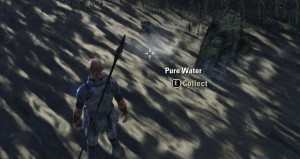
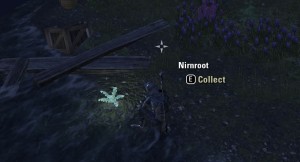

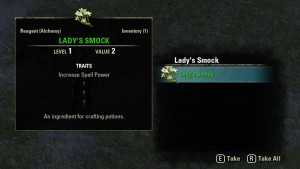
To me it seems like Detection and Stun are debuffs, or?
I put it into javascript and generated all 292 combos.
But only 90 different potions with at least one buff.
http://www.puzzleslogic.com/eso/alchemy.html
Stun is definitely a debuff, but Detection is a buff – it is something like Magelight, you can see hidden enemies.
I like your chart, I will use it a lot with my Khajiit crafter!
Yes. Detection – Invisibility is special pair of 2 buffs.
There is one more error in that table picture. “Luminous Russula” and “Stinkthorn” affect weapon power as written in text and not spell power as shown on image. (or is table correct and text wrong?)
There are plants in different quality levels? So green, blue, etc.?
Nope, all plants have the same quality level.
I’ve looked over DOZENS of alchemy guides, and all are missing 1 key thing. A Zone list for where to find each solvent, natural and clear are both in your lvl 1-15 zones but what about Filtered Water, I’ve hunted all over for it with no luck, be the first guide to tell me what zones have it LOL
I think you’ll have the best luck hunting for Filtered Water in Coldharbour.
I thought so to, i’ve opened every box i could… Purified Water… go to Reaper’s March, Cleansed Water, being a 40ish zone both should have Filtered Water.
Here is a way to get the most out of each and every single ingredient it shows what they do and which ones the other ingredients combined with. If you want to use this to add on page go ahead I don’t have a clue how but I bet this will help everyone level the alchemy faster and make potions stronger since each ingredient will be used to its full potential.
Blessed Thistle =1Restore Stamina, 2Ravage Health, 3Increase Weapon Potency, 4Speed (Dragonthorn 1+3)
Blue Entoloma = 1Ravage Magic, 2Restore Health, 3Invisibility, 4Lower Spell Power, (White Cap 1+4)
Bugloss = 1Increased Spell Resist, 2Lower Spell Power, 3Restore Health, 4Restore Magic (Columbine 3+4)(White Cap 1+2)
Columbine = 1Restore Health, 2Restore Stamina, 3Restore Magic, 4Unstoppable (Bugloss 1+2)(Mountain Flower1+2)
Cornflower = 1Restore Magic, 2Ravage Health, 3Increase Spell Power, 4Detection (Ladys Smock 1+3)(Violet Coprinus 2+3)
Dragonthorn = 1Increase Weapon Potency, 2Lower Armor, 3Restore Stamina, 4Weapon Critical (Blessed thistle 1+3)(Stinkhorn 1+3)
Emetic Russula = 1Ravage Health, 2Ravage Stamina, 3Ravage Magic, 4Stun (Stinkhorn 1+3)(Violet Coprinus 1+2)
Imp Stool = 1Lower weapon Power, 2Increase Armor, 3Ravage Stamina, 4Lower Weapon Critical (Luminus Russula 1+2)
Ladys Smock = 1Increase Spell Power, 2Lower Spell Resist, 3Restore Magic, 4Spell Critical (Cornflower 1+3)Violet Coprinus 1+3)
Luminus Russula = 1Ravage Stamina, 2Restore Health, 3Lower Weapon Power, 4Reduce Speed (Imp Stool 1+2)(Mountain Flower 2+3)
Mountain Flower = 1Increase Armor, 2Lower Weapon Power, 3Restore Health, 4Restore Stamina (Bugloss 3+4)(Luminus Russula 2+3)
Namira’s Rot = 1Spell Critical, 2Invisibility, 3Speed, 4Unstoppable (none has 2)
Nirnroot = 1Ravage Health 2Lower Weapon Critical, 3Lower Spell Critical, 4Invisibility (none has 2)
Stinkhorn = 1Lower Armor, 2Increase Weapon Potency, 3Ravage Health, 4Ravage Stamina (Emetic Russula 2+4)(Dragonthorn 1+4)
Violet Corpinus = 1Lower Spell Resist, 2Increase Spell Power, 3Ravage Health, 4Ravage Magic (Cornflower 2+3)(Emetic Russula 2+4)(Ladys Smock 1+3)
Water Hyacinith = 1Restore Health, 2Weapon Critical, 3Spell Critical, 4Stun (none has 2)
White cap = 1Lower Spell Power, 2Ravage Magic, 3Increase Spell Critical, 4Stun (Blue Entoloma 1+2)(Bugloss1+3)
Wormwood = 1Weapon Critical, 2Reduce Speed, 3Detection, 4Unstoppable (none has 2)
Ah the image above is what i based first one on and figured out theres a few that were not correct so this should fix it.
Here is a way to get the most out of each and every single ingredient it shows what they do and which ones the other ingredients combined with. If you want to use this to add on page go ahead I don’t have a clue how but I bet this will help everyone level the alchemy faster and make potions stronger since each ingredient will be used to its full potential.
Blessed Thistle =1Restore Stamina, 2Ravage Health, 3Increase Weapon Potency, 4Speed (Dragonthorn 1+3)
Blue Entoloma = 1Ravage Magic, 2Restore Health, 3Invisibility, 4Lower Spell Power, (White Cap 1+4)
Bugloss = 1Increased Spell Resist, 2Lower Spell Power, 3Restore Health, 4Restore Magic (Columbine 3+4)(White Cap 1+2)
Columbine = 1Restore Health, 2Restore Stamina, 3Restore Magic, 4Unstoppable (Bugloss 1+3)(Mountain Flower1+2)
Cornflower = 1Restore Magic, 2Ravage Health, 3Increase Spell Power, 4Detection (Ladys Smock 1+3)(Violet Coprinus 2+3)
Dragonthorn = 1Increase Weapon Potency, 2Lower Armor, 3Restore Stamina, 4Weapon Critical (Blessed thistle 1+3)(Stinkhorn 1+3)
Emetic Russula = 1Ravage Health, 2Ravage Stamina, 3Ravage Magic, 4Stun (Stinkhorn 1+3)(Violet Coprinus 1+2)
Imp Stool = 1Lower weapon Power, 2Increase Armor, 3Ravage Stamina, 4Lower Weapon Critical (Luminus Russula 1+2)
Ladys Smock = 1Increase Spell Power, 2Lower Spell Resist, 3Restore Magic, 4Spell Critical (Cornflower 1+3)Violet Coprinus 1+3)
Luminus Russula = 1Ravage Stamina, 2Restore Health, 3Lower Weapon Power, 4Reduce Speed (Imp Stool 1+2)(Mountain Flower 2+3)
Mountain Flower = 1Increase Armor, 2Lower Weapon Power, 3Restore Health, 4Restore Stamina (Bugloss 3+4)(Luminus Russula 2+3)
Namira’s Rot = 1Spell Critical, 2Invisibility, 3Speed, 4Unstoppable (none has 2)
Nirnroot = 1Ravage Health 2Lower Weapon Critical, 3Lower Spell Critical, 4Invisibility (none has 2)
Stinkhorn = 1Lower Armor, 2Increase Weapon Potency, 3Ravage Health, 4Ravage Stamina (Emetic Russula 2+4)(Dragonthorn 1+4)
Violet Corpinus = 1Lower Spell Resist, 2Increase Spell Power, 3Ravage Health, 4Ravage Magic (Cornflower 2+3)(Emetic Russula 2+4)(Ladys Smock 1+3)
Water Hyacinith = 1Restore Health, 2Weapon Critical, 3Spell Critical, 4Stun (none has 2)
White cap = 1Lower Spell Power, 2Ravage Magic, 3Increase Spell Critical, 4Stun (Blue Entoloma 1+2)(Bugloss1+3)
Wormwood = 1Weapon Critical, 2Reduce Speed, 3Detection, 4Unstoppable (none has 2)